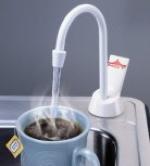Search engine visitors - click here to access entire "$ensible Home" web site
Click here to see a descriptive illustration showing several types of hot water dispensers.
Dear Jim: We drink a lot of coffee and other hot beverages. I thought of installing a hot water dispenser in the kitchen for convenience. Are these useful and will using one decrease or increase my utility bills? - Glen J.

A: If you think about it, you will realize how many times you really do use hot water throughout the day. A hot beverage is only one use. Hot water is also often run over a fresh jar so the top opens easier. Other uses are warming a baby food jar or an ice cream scoop, cleaning a cheese grate, etc.
Using hot water from the kitchen faucet is very wasteful of both water and energy. Depending upon how far your kitchen faucet is from the water heater, each time you need it, you may have to run more than a gallon of water down the drain until the hot water finally reaches the faucet. This wasted water is replaced by cold incoming water from a water main or well which is well below ambient room temperature.
After you turn the hot water faucet off, the hot water pipe is still full of hot water. During the winter, this slowly cools off and helps heat your house to some extent so it is not a total loss. Keep in mind though, an electric water heater is only about one-third as efficient as a heat pump. During the summer, the hot water in the pipe creates a double cost because it is additional heat which your air conditioner must remove from your house.
A hot water dispenser is a tiny tank-type electric water heater located beneath your sink with a spout near the faucet. This is different from an electric whole-house tankless water heater which draws huge amounts of electric current and requires new special heavy wiring and circuits.
A hot water dispenser typically has a heavily insulated one-half-gallon water tank located under the sink. Combining the hot water in the tank with the output of the heating element, it produces enough hot water for about 50 cups per hour. Most have optional built-in water filters. Small countertop models which use bottled water and include a chiller are also available. These countertop models are usually rented from a drinking water company.
Hot water dispensers are convenient to use and easy to install. They have adjustable temperature settings, often from 140 degrees for cleaning and warming tasks to 190 degrees for coffee or tea. There generally is a temperature adjustment knob on the tank unit under the sink. They operate on standard 120-volt house power, so they do not require special wiring.
Whether or not one will save electricity overall depends upon your hot water usage habits. Most hot water dispensers have 700- to 800-watt heating elements. They also operate on a thermostat so the electric heating elements are on only when needed. As with any water heating device, set its temperature only as high as you need it. A lower setting requires less electricity to keep the tank warm.
If you do not mind waiting for a microwave oven to heat water each time you want coffee or tea, and if you do not otherwise use much hot water, installing a hot water dispenser will likely increase your utility bills. For example, being a single man who does not drink coffee, I have not installed one in my own home. On the other hand, if you use hot water often from the faucet and heat water on the stove, using a hot water dispenser can lower your utility bills.
Another time- and money-saving advantage of a hot water dispenser is for cooking. Most experts do not recommend using hot water from the faucet for starting rice or other foods. The reason is hot water standing and running through the pipes in a house is more likely to pick up chemicals or contaminants than is cold water. Also, the hot water from the faucet is probably only in the 120 degree range.
With the hot water dispenser tank located directly under the sink, picking up contaminants is not a problem because all the plumbing from the tank to the spout is included with the kit. When you plan to steam or boil foods, you can start with 190-degree hot water from the dispenser. This will reduce the stove-top cooking time of many foods and will save energy.
Instant Download Update Bulletin No. 722 - buyer's guide of 10 hot water dispenser manufacturers listing storage tank capacity, tank dimensions, spout styles, faucet dispenser colors, electrical specification (wattage and voltage), thermostat range, features, prices, suggested uses for hot water dispensers; buyer's guide or bottled water coolers/heaters showing types, cabinet shapes, cabinet colors, hot tank specifications, cold reservoir specifications; suppliers of delivered bottled water and coolers, brands available, water types, sizes available, dispensers and features.
Dear Jim: I plan to install a central vacuum cleaning system. I am debating whether to vent it outdoors, into my garage or the basement. What is the best way to vent it to minimize the dust inside my home? - Sandi P.
A: All of the above three venting options are commonly used. I vent my own central vacuum system into my basement. To minimize dust, outdoor venting is probably best, but then you will lose conditioned indoor air too.
Most of the new central vacuum power units have excellent filtration systems, so the air that blows out is very clean. After two years of use, I have not noticed any dust buildup around mine in the basement near the exhaust.